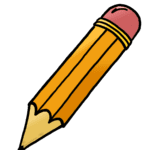
Handwriting is an important area of development for children. Occupational therapists in the school setting often develop goals surrounding handwriting as handwriting includes many different skills such as upper body strength, posture/positioning, attention, fine motor coordination, visual motor skills, and fine motor skills. Below is a list of different aspects of handwriting and some examples to assist with the below areas:
Learning Letters:
- Letters in print should be written from top to bottom and from left to right.
- A multi-sensory approach to learning is a great approach for all children. Prepare a tray or baking pan with a shallow layer of any
impressionable substance (sand, sugar, salt, bird seed, rice, pudding, shaving cream, etc.) Practice forming letters and numbers
using the index (pointer) finger. Remember to form letters from top to bottom and from left to right. - Pre-write letters on paper and have the child trace over them with glue (squeeze bottle type)
- Form letters by gluing beans, rice, seeds, etc. on paper
- Form letters with putty, play doh, clay, modelling compound, etc.
- For letter recognition, have child read through a story at his/her reading level and circle all of the a’s or b’s, etc.
- Write letters in the air with the pointer finger and large arm movements. Try it with eyes closed, then eyes open.
- Write letters on your child’s back and see if he/she can guess what letter it is. Write on each other’s palms
Writing letters from top to bottom:
- Forming letters to write words in a consistent direction is the most efficient way to write. For printing, the top-down method is
best. - Write letters in the air with the pointer finger and with large arm movements. Try it with eyes closed, then eyes open.
- Write letters on your child’s back and see if he/she can guess what letter it is. Write on each other’s palms
- On a large chalk board or dry erase board, write large letters, always starting at the top.
- Write letters on paper that is placed over a textured surface, such as sandpaper, plastic craft canvas or rubbing plates. The
tactile feedback from the bumpy surface will increase the child’s memory for correct letter formation.
Writing on Lines:
- Highlight the bottom half of the line. Instruct the child to “stay in the yellow” (or whatever colored was used) for all the small
letters; tall letters start at the top line and descending letters dive down from the middle. - Darken the lines to increase awareness; sometimes copying paper on the darkest setting will make the lines easier to see.
Spacing:
- Teach child to “finger space”: place his/her left index finger (if right handed) after each word the child writes
- Have child place a dot with a stamp marker or highlighter after each word as a spacer, or to make a small dot with the pencil; later
the child can erase the dots. - It’s better to have large exaggerated spaces, especially for young writers. Using 2 fingers to space may be a good way to start or an item between words such as a skittle.
Letter and Number Reversals:
- Reversals of numbers and upper case letters can be fixed by writing within boxes (rectangular shaped and oriented to be tall
rather than wide). - Lower case letter reversals are commonly seen with the letters b/d, p/q/g, w/m, j, s and z.
- Form letters with putty, play doh, clay, pipecleaners, etc.
- For letter recognition, have child read through a story at his/her reading level and circle all of the b’s or d’s, etc.
- Write letters in the air with the pointer finger and large arm movements. Try it with eyes closed, then eyes open.
- Write letters on your child’s back and see if he/she can guess what letter it is. Write on each other’s palms
Pencil Grasp:
- People hold pencils and other writing tools in a variety of ways. The most common grip is called a “tripod” grip. This involves
pinching the pencil between the pads of the thumb and index finger while the pencil rests on the side of the middle finger. Many
people use a quadrupod grip which is similar except two fingers are on top of the pencil opposing the thumb and the pencil rests on
the side of the ring finger. And there are many variations, not necessarily wrong or needing to be corrected. - When coloring, drawing and writing use short writing and drawing tools such as broken crayons, golf pencils,
short colored pencils, or small bits of chalk
Posture for Writing:
- Ideal sitting posture for writing is to be upright in the chair with the hips and knees at 90 degrees and feet
- The head should be a reasonable distance from the paper, about 12 to 20 inches.
- When writing, the wrist should be in a neutral position or slightly extended (hand bent back).
- The best writing surface is a slanted one. This helps to keep the head upright and supports the forearm and hand in the optimal
position for writing. Most school desks are not slanted but a simple modification is to use a wide 3-ring binder (3 to 4 inch spine)
turned sideways.
Adapted from: http://therapystreetforkids.com/Handwriting.html
